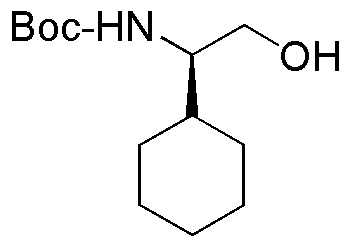Boc-D-cyclohexylglycinol is widely utilized in research focused on:
- Peptide Synthesis: This compound serves as a protecting group in the synthesis of peptides, enhancing the efficiency of the process by preventing unwanted reactions during chemical modifications.
- Drug Development: Its unique structure allows for the design of novel pharmaceuticals, particularly in the development of compounds targeting neurological disorders, where cyclohexyl groups can improve bioavailability.
- Chiral Catalysis: Boc-D-cyclohexylglycinol is used as a chiral auxiliary in asymmetric synthesis, providing researchers with a reliable method to produce enantiomerically pure compounds, crucial in the pharmaceutical industry.
- Bioconjugation: The compound is employed in bioconjugation techniques, facilitating the attachment of drugs to biomolecules, which can enhance therapeutic efficacy and specificity in targeted drug delivery systems.
- Research in Organic Chemistry: It serves as a versatile building block in organic synthesis, allowing chemists to create complex molecules with specific functional groups, thereby advancing research in material science and medicinal chemistry.
General Information
Properties
Safety and Regulations
Applications
Boc-D-cyclohexylglycinol is widely utilized in research focused on:
- Peptide Synthesis: This compound serves as a protecting group in the synthesis of peptides, enhancing the efficiency of the process by preventing unwanted reactions during chemical modifications.
- Drug Development: Its unique structure allows for the design of novel pharmaceuticals, particularly in the development of compounds targeting neurological disorders, where cyclohexyl groups can improve bioavailability.
- Chiral Catalysis: Boc-D-cyclohexylglycinol is used as a chiral auxiliary in asymmetric synthesis, providing researchers with a reliable method to produce enantiomerically pure compounds, crucial in the pharmaceutical industry.
- Bioconjugation: The compound is employed in bioconjugation techniques, facilitating the attachment of drugs to biomolecules, which can enhance therapeutic efficacy and specificity in targeted drug delivery systems.
- Research in Organic Chemistry: It serves as a versatile building block in organic synthesis, allowing chemists to create complex molecules with specific functional groups, thereby advancing research in material science and medicinal chemistry.
Documents
Safety Data Sheets (SDS)
The SDS provides comprehensive safety information on handling, storage, and disposal of the product.
Product Specification (PS)
The PS provides a comprehensive breakdown of the product’s properties, including chemical composition, physical state, purity, and storage requirements. It also details acceptable quality ranges and the product's intended applications.
Certificates of Analysis (COA)
Search for Certificates of Analysis (COA) by entering the products Lot Number. Lot and Batch Numbers can be found on a product’s label following the words ‘Lot’ or ‘Batch’.
Numéro de catalogue
Numéro de lot/série
Certificates Of Origin (COO)
This COO confirms the country where the product was manufactured, and also details the materials and components used in it and whether it is derived from natural, synthetic, or other specific sources. This certificate may be required for customs, trade, and regulatory compliance.
Numéro de catalogue
Numéro de lot/série
Safety Data Sheets (SDS)
The SDS provides comprehensive safety information on handling, storage, and disposal of the product.
DownloadProduct Specification (PS)
The PS provides a comprehensive breakdown of the product’s properties, including chemical composition, physical state, purity, and storage requirements. It also details acceptable quality ranges and the product's intended applications.
DownloadCertificates of Analysis (COA)
Search for Certificates of Analysis (COA) by entering the products Lot Number. Lot and Batch Numbers can be found on a product’s label following the words ‘Lot’ or ‘Batch’.
Numéro de catalogue
Numéro de lot/série
Certificates Of Origin (COO)
This COO confirms the country where the product was manufactured, and also details the materials and components used in it and whether it is derived from natural, synthetic, or other specific sources. This certificate may be required for customs, trade, and regulatory compliance.


